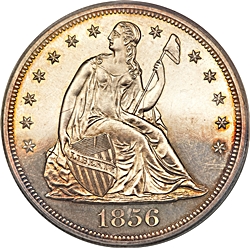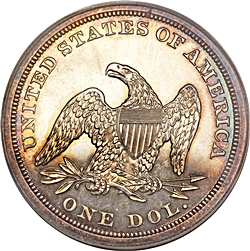 |
1856 
 |
 |
General Comments1856 is a semi-key date in the Liberty Seated dollar series. Its mintage, low by general standards, but mid-range for Seated dollars, doesn’t properly indicate its rarity. With a mintage ranking of 30th out of 47 the collector would expect that it would be easy to locate, but that’s usually not the case. It can be found with patient searching, but it’s not readily available. Mint state examples are truly rare. The finest known examples are MS64. Current population reports show three MS64 examples graded by PCGS, two by NGC. Even with only 5 reported its very possible that one or two of these are re-submissions. An additional ten examples are graded MS63, six by PCGS, four by NGC. A total of 33 coins have been graded mint state by the two major services, making this one of the toughest coins in the series in high grades. Population statistics are as of January, 2019. The finest known proof is a single PR67 Cameo graded by NGC. Four coins have been graded PR66, one by PCGS and three by NGC. The PCGS coin is PR66+, the highest graded by that service. NGC has also graded 6 coins PR65. PCGS has graded three at that level. Several of these gem examples are almost surely re-submissions. Twenty-eight coins have been graded PR64, eleven at PCGS, seventeen at NGC. A total of 69 coins have been graded as problem-free proofs by the two major grading services. Population statistics are as of January, 2019. |
|
1856 Die Marriages
Die Marriage |
Rarity |
Obverse Die |
Reverse Die |
Estimated Survivors |
| OC-1 | R2 | 1 | A | 600 |
| OC-P1 | R5 | P1 | PA | 50 |
A single die pair was used to strike all business strikes. We’ve identified this die pair as OC-1. Neither die was used for proofs. No clash marks have been observed, but the reverse is normally heavily cracked. We’ve seen two examples with perfect dies, but this die state seems to be extremely rare. OC-1 is a very interesting die marriage. The obverse die has long been identified as an overdate. Many early references called it 1856/4. Breen included this variety in his Encyclopedia (reference 20) as Breen 5454 and listed it as “extremely rare”. He also included a normal date variety, Breen 5453. In 2012 we determined that the 1856/4 is actually a repunched date, 1856/6, with the underlying 6 rotated by approximately 45 degrees. Our findings were documented in an article in the Gobrecht Journal (reference 12). Moreover, it’s the ONLY 1856 variety. Only one die was used for all business strike issues, with the early die states clearly showing the under-digit, the late states less so. We’ve included this variety (early die state only) as one of our Top-30.
The single proof variety, OC-P1, paired a unique obverse die with a reverse die that was used again in 1857 and 1858, and subsequently for several restrikes. It’s a rare proof, with only 50 or so estimated survivors from an estimated mintage of 80. Attribution of proofs is simple since the date shows none of the repunching that’s characteristic of the business strikes.
1856 Business Strike Emission Sequence
With only one business strike die marriage the emission sequence isn't terribly interesting.
Emission Order |
Die Marriage |
Comments |
| 1 | OC-1 |
1856 Proof Emission Sequence
The proof emission sequence is just as interesting as the business strike sequence.
Emission Order |
Die Marriage |
Comments |
| 1 | OC-P1 |
1856 Quick Finder Chart
With only two die marriages, one business strike and one proof, attribution is easy. The following table summarizes the key features that identify each die.
Die Marriage |
Obv. Die |
Rev. Die |
Right Base |
Keys to Identification |
| OC-1 | 1 | A | RE | Obverse: Base of 1 is RE. Notable repunching on the 6.
Reverse: Lumps extend from the left edge of the left wing. Most die states exhibit numerous die cracks. |
| OC-P1 | P1 | PA | JL of RE | Obverse: Base of 1 is JL of RE. Perfect 6, NO repunching. Reverse: Die rust lumps on the L in DOL and first S in STATES. |
| Photo credits:
Obverse and reverse full photos: PCGS PR63, from the Heritage archives. |
